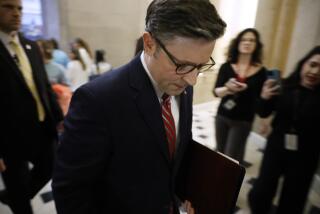Deficit-busting ‘super committee’ was doomed to failure
So once again, political leaders in Washington have lived down to the expectations of business owners and consumers — just about everyone. Having set up a “super committee” to consider how to cut federal red ink by at least $1.2 trillion over 10 years, Congress this week conceded a self-inflicted defeat.
Is this failure good or bad for the economy? In the long run it’s probably neutral, because it doesn’t say anything about the absence of grown-up economic policy thinking in Washington that we didn’t know already.
When business owners or consumers are asked for their views on our economic head winds, deficit-reduction never ranks very high, or at all. What tops the list? The need to spur economic demand and to address unemployment, today.
From its inception, the super committee was a distraction from this imperative. If you need any more proof, you can examine the figures on third-quarter gross domestic product growth released this week: a piffling 2%, revised down from 2.5%.
The super committee idea looked good in headlines — maybe only in headlines. The committee was to produce a package of deficit-reduction measures — spending cuts or tax increases or both — to be voted on by Congress without amendment or filibuster.
To the extent the enacted package fell short of $1.2 trillion over 10 years, the slack was to be picked up by automatic, mandated cuts split evenly between defense and non-defense items.
In the event of total failure, that would translate into $492 billion in each category, with the remaining $216 billion accounted for in lower interest payments on the consequently lower federal debt.
The required cuts were designed to be so draconian that the 12 super committee members would see they had no choice but to create a package of their own, and Congress would be stampeded into passing it, like a herd of panicked bison. Now that the committee has failed, those automatic cuts are triggered — but they don’t kick in until 2013, leaving plenty of time for Congress to renege on its budgetary self-denial.
This effort was doomed to failure on multiple levels. In quest of a deficit-reduction number, the committee threw programs on the table — Medicare here, defense procurement there — as if nothing mattered but arithmetic. But they took tax increases off the table, which is tantamount to trying to do math without using integers.
The Bush tax cuts of 2001 and 2003 are central to this calculation. The budgetary cost of those cuts for taxpayers earning roughly $200,000 and up and certain investment incentives has been estimated by the Joint Tax Committee at about $100 billion for 2012, give or take $10 billion or so (revenue estimating is something of a black art).
Let those cuts expire for high-income taxpayers as scheduled Dec. 31, 2012, and you might be most of the way to closing a $1.2–trillion budget gap without doing anything else.
There were even more basic problems with the super committee. One was Congress’ failure to recognize, understand or acknowledge that pretty much 100% of the deficit growth going forward stems from rising healthcare costs. Who says so? The Congressional Budget Office, for one, which has projected the federal share of those costs rising to nearly 10% of gross domestic product in 2035 from 5.6% this year.
That points policy one direction: find a way to restrain healthcare costs without imposing undue burdens on the weakest and sickest members of society. A super committee devoted to that goal would have had a crack at creating a lasting economic legacy.
But the central problem was the very notion that deficit reduction is the most pressing fiscal issue facing the country. The super committee — indeed, every sensate being in Washington and across the country — has seen plenty of evidence that the most pressing issue is short-term economic growth.
Pump up growth, and even the long-term deficit begins to take care of itself. In October, the CBO estimated for the House Budget Committee that fully one-third of the deficit projected for 2012 was the result of the economic slump. Put another way, the projected deficit would be $630 billion, not $973 billion, if the economy were operating at full tilt.
Last week, the same agency gave Congress a crystal-clear roadmap for getting the economy back on that path. The single most cost-effective option for creating consumer demand is extending unemployment assistance — every dollar spent results in as much as $1.90 in GDP over two years.
Nothing else comes close, the CBO says, although reducing employers’ payroll taxes (as much as $1.30) and providing tax relief to lower- and middle-income households ($1.20) also are highly effective. And all of the most common other proposed fiscal options, such as federal infrastructure building and aid to states for the same purpose, translate into significant employment gains. That would mean more economic demand and more recovery.
The super committee’s pedigree should have been a warning that it was going to come apart. The panel was created as part of the solution to the debt-ceiling standoff last summer, an event that elevated stupidity into a legislative principle. Now that the super committee is bust, Congress needs to turn its attention to those other fiscal policy options, all of which are crying out for enactment before Congress adjourns for the end of the year.
Michael Hiltzik’s column appears Sundays and Wednesdays. His latest book is “The New Deal: A Modern History.” Reach him at [email protected], read past columns at latimes.com/hiltzik, check out facebook.com/hiltzik and follow @latimeshiltzik on Twitter.
More to Read
Inside the business of entertainment
The Wide Shot brings you news, analysis and insights on everything from streaming wars to production — and what it all means for the future.
You may occasionally receive promotional content from the Los Angeles Times.











